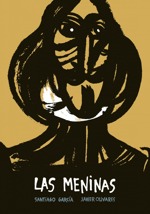Max:
Comics Art in Spain

For more the four decades, from Spain’s local countercultural margins to international acclaim today, the ever-changing comics of Spanish artist Max, alias Francesc Capdevilla, have responded to his personal perspectives and the spirit of the times. Max emerged under the repressive Franco regime, debuting his work in 1973 in truly subversive ‘underground’ comix which the authorities pounced upon for ‘infringing public morals’. Post-Franco freedoms unleashed his angry radical Gustavo, then his punk distortion of Barrie’s fantasy Peter Pank, and more recently the bizarre, balding Bardin, inheritor of Superrealist powers from Luis Buñuel’s Andalusian Dog.

Max’s latest graphic novel translated by Fantagraphics purifies and condenses his cartooning and thinking still further. Vapor charts the struggles and strange encounters of Nicodemos, a long-haired, long-nosed monk, who has quit the ‘gigantic muddle’ of the world to seek transcendence in a desert through self-deprivations. Max admits, “Some people say my concerns are too philosophical, but they grow from plain reality. What can you do if, like me, you can’t stand the world as it is now? What if I leave everything behind, go to the wilderness, stay quiet there, let things flow? Will I find peace of mind, or find a God or something?”

Beset by hunger, thirst, boredom and desire, Nicodemos or ‘Nick’ meets (or imagines?) a no-nonsense Felix-like cat, a magpie whose stolen food saves his life, a pig-farmer whose axe chops down a vast forest, his own shadow who abandons him, and the Queen of Sheba’s seductive parade. Somehow overcoming all distractions, Nick finally faces the beaked, one-eyed flexible force of Vapor itself and must make the ultimate choice.


The gallery world has been discovering the power of Max’s ideas and graphics. Having toured Spain, Mexico and Brazil in 2011-12, Max’s career retrospective Panòptica was updated and expanded in 2014 at the Ars Santa Mónica Gallery in Barcelona. Max was also given carte blanche by one of his regular employers, the El País newspaper, to create a new piece for the Arco Contemporary Art Fair in Madrid two years ago. Paseo astral (‘Astral Stroll’) turns forty-five newsprint pages into single-sheet panels composed of ink drawing and collage. As Max explains, “It’s about an artist looking for inspiration. He falls asleep reading the newspaper and starts an astral trip travelling through all the pages (international, national, economics, editorial pages, society, culture…) looking for the muse and meeting the devil - at a crossroads, of course.”

For inspiration for Max’s new untitled Strip for ArtReview (rough and finished colour comic, below), he ponders his mixed experiences of the art world and its tendency for po-faced self-importance. In his view, “The ‘visual’ look of comics has been assumed as a trend, as part of ‘pop’ and ‘pulp’ aesthetics. But the core of comics is telling stories through visuals, whereas contemporary art seems uninterested in stories, it is just interested in theories. And it wants to be ‘serious’. There is a huge cultural prejudice against fun. If something is fun, it can’t be taken seriously.” Contradicting this, the vehicle of comics permits Max to blend the playful and the profound into a metaphysical tour de force.




‘Untitled’ for ArtReview Magazine
Click images to enlarge.
Web Exclusive Interview:
Max kindly agreed to answer of few of my questions for the above feature. Here are his full answers…

Paul Gravett:
From the marginalised, low-circulation underground to high-profile international acclaim, your journey with comics has seen huge change. Has it all been positive or has anything been lost in this process?
Max:
Nothing lost, except, of course, youth and its rage and a certain unconsciousness - in this case meaning lots of action but little reflection. Now it’s the other way around for me: not much action, and tons of reflection instead, but the result seems to be almost the same: still raging at this stupid world.
What have been your experiences, good and maybe not so good, of bringing your comics into the contemporary art world?
Well, my experience is neither good nor bad: plain indifference is what I have encountered. I’d say the contemporary art world is still ignoring comics. The “visual” look of comics has been assumed, of course, even as a trend in the last few decades, it is a part of “pop” and “pulp” aesthetics. But what about the core of it? The core of comics is exactly telling stories through visuals, but contemporary art seems to not be interested in stories, it is just interested in theories. And, moreover, it wants to be “serious”. In the end, I guess there is a huge cultural prejudice against fun. If something is fun, it can’t be taken seriously.
That said, around the world there seems to be an increasing inclusion of comics art within galleries and museums - why do you think this is happening, what do you feel about it?
I have mixed feelings. Of course, I acknowledge comics as an art form, so I welcome the fact that it is finding a place in galleries and museums, but at the same time I acknowledge that comics have always developed in the margins of culture, in the ditch; and I guess that’s exactly the point that gave comics its unique creative potential and freedom. I wonder what happens when you go from lowbrow to highbrow…

Have you ever made work intended for galleries? Are you interested in exploring this path as other comics creators have done, for example with narrative installations or adding to their story worlds? If so, or if not, why?
I am interested, yes, I think there is a common ground to share. And I’ve done it when I’ve had the chance. I did something specifically for the Arco Contemporary Art Fair in Madrid two years ago. The newspaper El País had a big space there and they offered it to me giving absolute freedom. I did Astral Stroll (‘Paseo astral’), a story in 45 newspaper-page, single-sheet panels, which was later published by La Cúpula as a book. It was about an artist looking for inspiration. He falls asleep reading the newspaper and starts an astral trip travelling through all the pages (international, national, economics, editorial pages, society, culture…) looking for the muse. There’s also a meeting with the devil at a crossroads (of course!). It was a mix of collage (the backgrounds being the real paper pages from one specific day, January 2nd) and ink drawing.
They were not for sale there, since it was not in the booth of a gallery, but of a newspaper. But that was not explicit, so I wondered if anyone would ask. I could have sold it privately after the show, and I was certainly willing to sell each piece - I guess the whole 45 drawings would have been unaffordable to most people. Only one man did ask, and found my price too high for him. So I still own the whole lot. But still… I can’t help but think that the perfect path for comics is the printed paper, instead of hanging on the wall.

Please describe some of the philosophical concerns you address in Vapor and why you think comics can convey them so well.
Some people say my concerns are too philosophical. All I can tell is that they just grow from plain reality. What can you do if you can’t stand the world as it is now? (in my case most days). Well, what if I quit and leave everything behind, go on my own to the wilderness, stay quiet there, let things flow…? What will happen then… will I find peace of mind, or a God or something… ? That’s what Vapor is about. I guess almost everyone can feel concerned about that. Comics can convey this subject as well as any other because it is a unique mix of visuals and narrative where the reader can fill all the gaps (and there’s a whole lot of them, from every panel to the next) with its own imagination and its own feelings.
You’ve tended to avoid autobiography in your comics to date. Why is this? Would you consider some form of autofiction in future? Or is Vapor really based on your own life and questions?
Some people may have interesting lives to tell, but not me. So I tend to work through fiction. But of course, the issues that lie deep behind the stories I write and draw are the issues that concern me, otherwise I’d be a faker.
You have long been active as a publisher, editor, festival organiser and all-round comics activist in Spain. How is the current culture for comics in Spain developing - what are the recent successes and challenges to come?
This question would need a whole book to answer. Let us say that Spain has always had a very strong comic tradition. But also that it has always been very much centred on the country’s issues itself. You needed to have the key to fully understand and enjoy Spanish comics, at least until the last decades of the last century. Nowadays, the Spanish comic scene is as global as any other can be, and the quality of the authors is really impressive, but the industry here is not so strong to hold onto them. Many of them are working for the French or American markets. But let me tell you just about one very recent book, probably the best so far this century: Las Meninas, the famous painting by Velázquez, written by Santiago García (script) and Javier Olivares (drawing) (below). It is a masterpiece, and I’m not joking.

This Article originally appeared in the December 2014 issue of ArtReview Magazine















